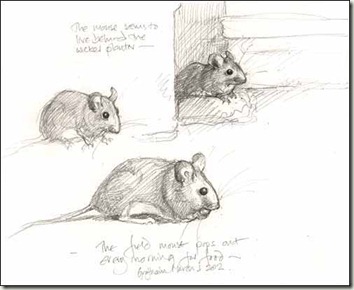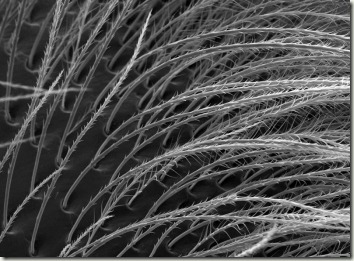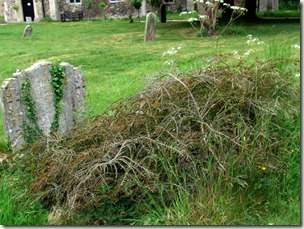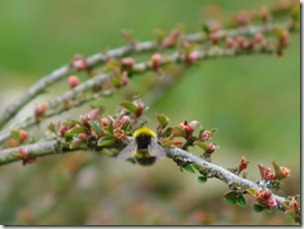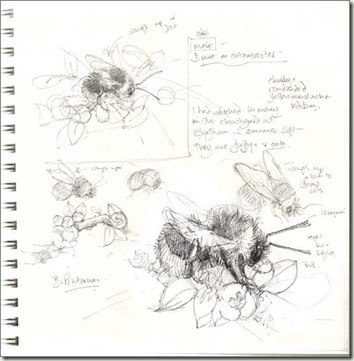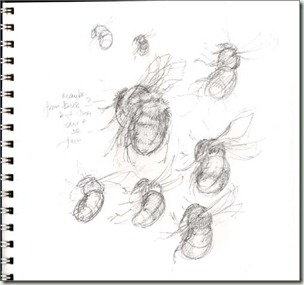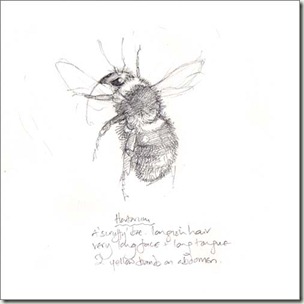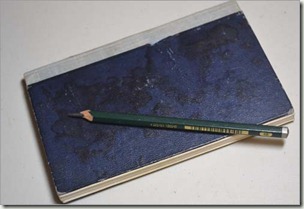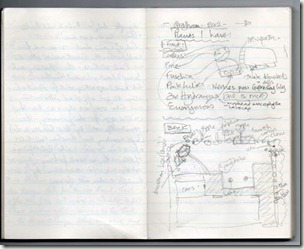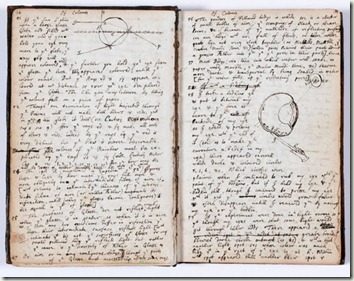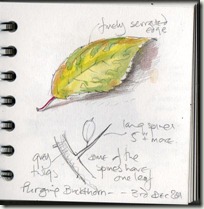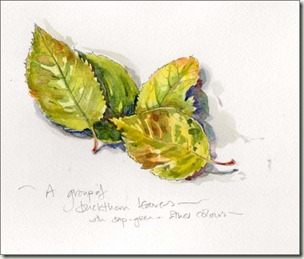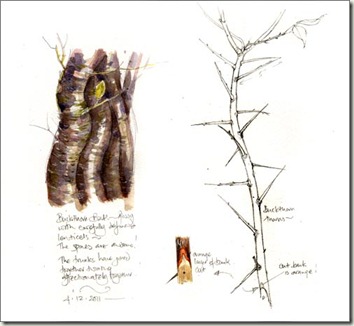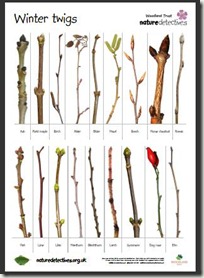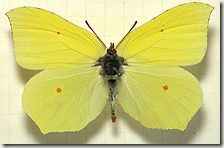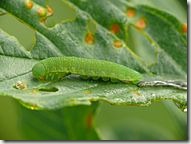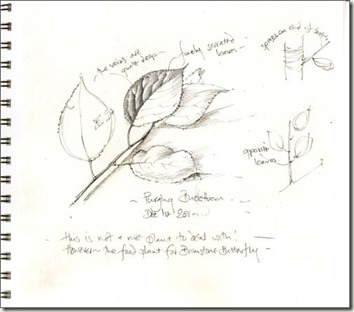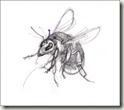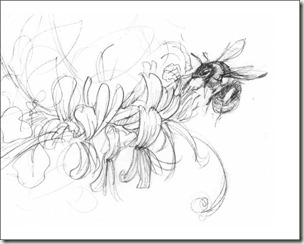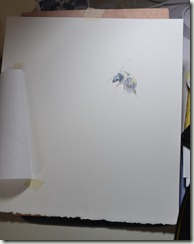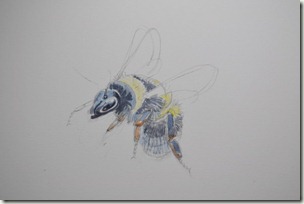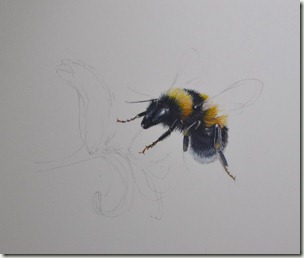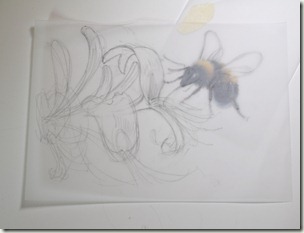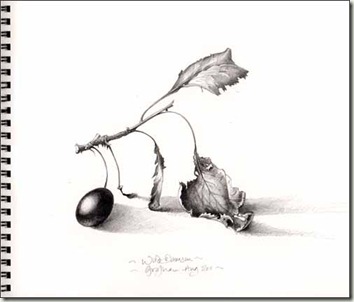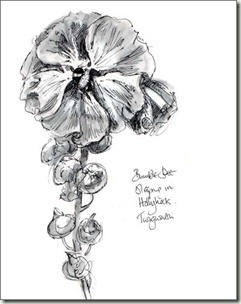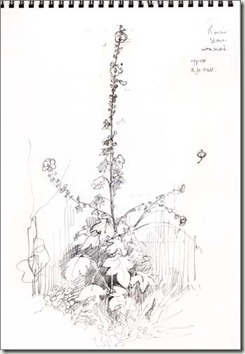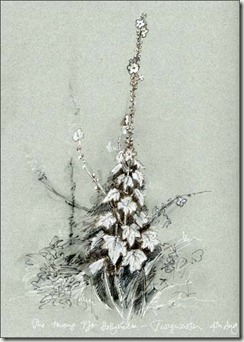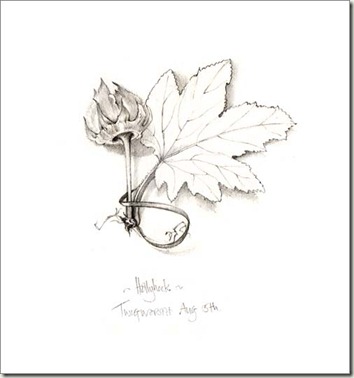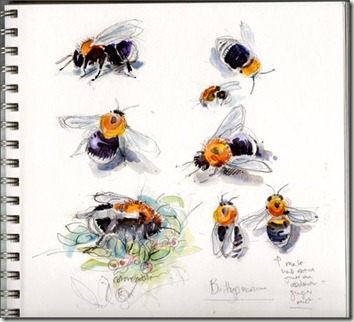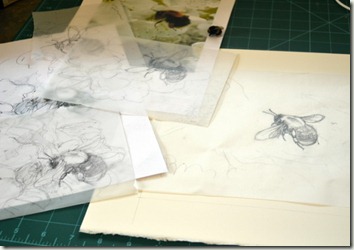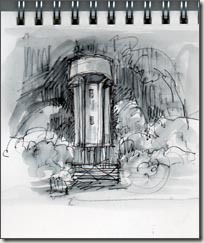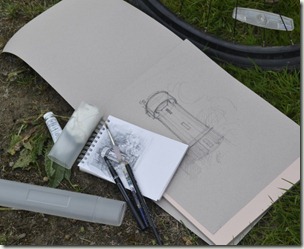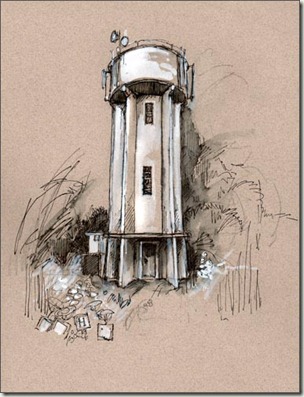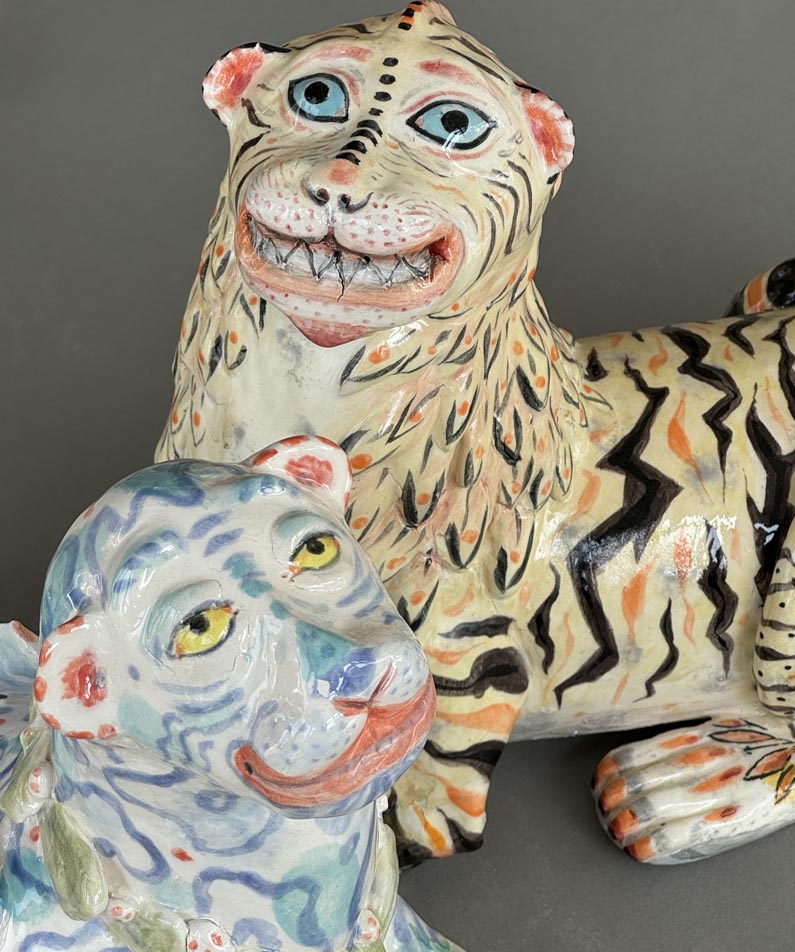Every morning Chris throws out a handful of bird food onto the concrete slabs by the kitchen door. It’s usually the robin, the blackbird and the “Gang of Three” starlings who are first there. Now we have a tiny mouse who creeps out from behind a planter.. rushes over to snatch a seed or a piece of cheese and rushes back. It is so charming. We only see it when it’s just getting light. It’s hard to see, but the scampering movements and those huge, shining, night vision eyes give it away. I am sure it is a common long tailed field mouse. Apodemus sylvaticus. All ears, eyes and whiskers, dark grey brown on top with a paler fur underneath. A few sketches to try to get my right arm and hand back into action. It’s reluctant and tells me it would rather be gardening, and I am very rusty.. in all senses. But work is piling up and its actually lovely to be able to sit down with the radio and my pencils again!
Tag: sketch
Bombus pratorum and the Hairiness of Bees
For this six bee commission I have decided to paint the male of this species. I saw so many of them last year and they are simply enchanting. They were zipping around the tiny flowers of the cotoneaster in the churchyard here.
They are easy to spot because of their bright lemony yellow colour and orangy tail, yellow moustache and long silky hair. They are extremely pretty.
The Hairiness of Bees
Bumble bees differ quite considerably in the quality of their hair. B hortorum for example, has quite long scruffy hair whereas B lapidarius has closer short dense hair more like velvet. The hair may differ between male and female.
The term used for bumble bee hair is “pile” (which always makes me think of carpet).
The hairs are referred to as “setae” and have a particular quality. Here is the explanation from the excellent BumbleBee.org which is packed with expert info.
“The other adaptation of the hair is that many are branched or feathery enabling more pollen to stick to them, as can be seen in the scanning electron microscope images (SEM) right, and below.
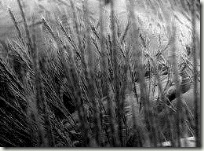
“When flying a bee builds up an electrostatic charge, the parts of a flower are usually well earthed, the stigma (the bit that leads to the ovary) more so than other flower parts, so as the bee enters the flower the pollen is attracted to the bee’s hairs and even grains of pollen that are not touched by the hairs can jump a few millimetres to the nearest hair. When a pollen covered bee enters a flower, because the stigma is better earthed than the other parts of the flower the charged pollen is preferentially attracted to it. So even if the large, hairy, bumblebee fails to brush against the stigma, the pollen can jump the few millimetres necessary for pollination.” Text and images from Bumblebee.org
Below another Scanning Electron Microscope photo of the hairs of US species B fraternus from Duke University.
A photo submitted to Springwatch in 2010 demonstrates the attraction of pollen to bees!
“Little bee © Mark Johnson from the 2010 Springwatch Flickr group!
Bombus Pratorum and Cotoneaster
The cotoneaster, where I watched the bees last May, has almost overtaken a particularly nice old grave in a part of the churchyard where wildflower spotting signs are displayed in the summer.
I am assuming it’s a Cotoneaster horizontalis, one I particularly like with its spreading, low growing habit, the tiny dainty flowers and leaves contrasting with the lichen covered gnarly branches. There are a couple of small ones in the garden here. I hope there will be bees!
A little B pratorum male.
Working out the pose and composition.
Mr Fluffy :)…. Painting the hair slightly ruffled hair will be a challenge.
Do Bees Have Characters?
It is something I often wonder when I am painting them. I am not particularly fanciful or overly sentimental but I do like to express something of what I think might be a bee’s character.
“Characteristic” is probably a more acceptable term for the naturalist or scientist. There certainly do seem to be differences between species and within species.. we describe different honey bee strains as “docile” or “aggressive”.
But that’s not really character.
Do bees get depressed or elated, is one Queen more attentive to her brood than another, one worker a harder worker than another?
I don’t know. I had been reading Sladen’s wonderful “The Humble Bee” again to remind myself of his observations, which were both affectionate and important.
I think he would have voted for character. He raised broods of bees in his garden and study so that he could watch and record them. Here he has found a searching lapidarius queen to take over small orphaned colony.
“I first introduced the queen to the brood. While she was yet an inch away from it she suddenly abandoned her ordinary dull and careless manner and , standing at attention , stretched out her antennae…. Then she advanced cautiously, and when half a minute later she reached the brood she showed great satisfaction and immediately stretched herself over it.”
On another occasion he has taken a queen out of her nest to eradicate some pesky ants. When he puts her back he notes.
“She was very pleased to get back to her brood. When I came to fill the honey pot I found the lump of comb had rolled almost off the sacking, so I hollowed the latter in the middle to retain it. The queen seemed to consider the brood to be insufficiently covered and ran about pulling and detaching bits of nest material with her jaws and carding them with her legs. She even tried to bite little pieces off the edges of the sacking. While thus occupied she frequently returned to the brood and always when she reached it emitted little buzzes of pleasure.” from FW Sladen’s The Humble Bee 1912.
Sketches I have been doing some more sketching to get me back into the shape of bumble bees. They pose problems because I like to try to show some part of the eye. Again it’s a human response ..we seek out eyes to engage with, even if they are not “eyes” in our sense. But their hunched shape means that in quite a few views the head is hidden.
For the B terrestris and honeysuckle I was wondering if I should tilt the view to look up, more of a worm eye view.
But with this bee it’s important to show the long head, the tongue and the characteristic two yellow stripes on the thorax
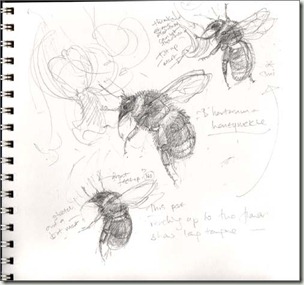
Eventually I decide on a side view.
So this Bombus hortorum will be “reaching up” with its front legs, approaching a honeysuckle flower.
To be less anthropomorphic perhaps I should just say “raising its front legs” because “reaching up” can signify a very human, emotionally charged, action.
It can be a request for help or for an embrace, an attempt to grasp something just out of reach, or to hold onto something to prevent a fall, or an appeal to be lifted up.
I have watched bees, especially bumble bees, reaching up to grasp the edges of petals.
Sometimes you feel you want to give them a helping hand and very often if you gently offer a finger for them to rest their back legs on they will willingly accept.
This is very non-scientific language I know, but it’s very endearing behaviour.
…and as my aim is to win the affection of kind hearted people and recruit them to the bee cause then my Bombus hortorum, here, will definitely be “reaching up”.
Garden (and others’) Note Book(s)
With this new garden I have decided to try to be systematic. I somehow know it will not last but it’s worth a try.
So I have started to keep a list of the plants already in the garden and the plants/seeds I buy. I would like to think I will carefully note their position, their progress, what I feed them with, cropping yields, (there’s optimism for you).. and of course bee attractivness etc
So I looked around for a notebook. I think I’ve mentioned before my aversion to new note books or sketchbooks and so the part-used old notebook tucked into the seed box at Dad’s house seemed both apt and appealing.
It’s a small 6 x 3 3/4 inch blue hardback with a grey cloth spine.
One of those anonymous note books without a makers name which you used to find in the old fashioned stationers. A great size to put in your pocket.
At the front there are a few pages of notes from a holiday in Madeira.
Mum has noted the children running home from school, Dad has made lists of costs.
At the back are notes detailing “Good Local Walks”, plant lists and plans for the garden i.e., “move white potentilla to west fence, eliminate wild onion weeds” (sorry Mum, I know they are still there). The earliest entry is 1987 and notes have been made by both Mum and Dad.
Mum and Dad’s notes: A list of plants and a page entitled “Spring 1998, after a long (cold) dry winter” with an enigmatic small end board sketch of something measuring 8 x17 x10 inches.
My first notes in the book with sketches of the garden.
As I was entering my first list, “Plants I Have”, I was also listening to the radio, to the fascinating BBC’s History of the Written World.
Melvyn Bragg was discussing how important writing was and possibly still is, to science. “how the invention of writing made the scientific revolution of the Enlightenment possible “ and how the note books of scientists were key in the processing, recording and passing on of information and ideas.
They were discussing Newton’s 1665 notes made in his twenties, of an experiment on his own eye which involved pushing a bodkin in between the eyeball and the bone and changing the shape of the eye.
On the BBC website there is Newton’s page …how wonderful. Isn’t the potency of the handwritten note and drawing extraordinary?
Even looking at this image on a computer screen sends a shiver up my spine. Prof Simon Schaffer describes the note books as “paper laboratories” a marvellous description.
The text reads
“I took a bodkin and put it between my eye and the bone as near to the backside of my eye as I could: & pressing my eye with the end of it there appeared several white, dark and coloured circles.”
You can listen to all of “The Written World” episodes on BBC Iplayer.
I can’t, unfortunately, make a comparison between the content of these notebooks, I can only find a comforting similarity in practice. Newton used both ends of his notebooks.. as did my parents.
My own inconsistency is so great that I use note books randomly, middle, end, upside down and sideways.. but there is very seldom anything on the first page.
I shudder to think what that might signify. The University of Cambridge is making Newton’s Papers available online see here for a wonderful, absorbing and humbling look at the work of an exceptional man.
There is, delightfully, a wealth of other inspirational notebooks on line. Here is Darwin’s famous “tree” from his Notebook B.
This note and sketch “depicts the branching system of descent with modification which he realized could explain the relationship between different species in the same class or family.” from Darwin Online.
And one of Leonardo’s notebook pages from the British Libraries, Turning The Pages site where you can view manuscripts and note books from composers writers and artists etc.
This page is from around 1508 “This double page forms a single sheet containing notes and diagrams relating to balances and weights, with a sketch of a cockleshell in the margin”
Hmm…nice sketch.
I embrace the internet and computers for all the wonderful things they have made possible, especially enabling me to access these fabulous documents from my desk….but I hope people still continue to jot down their lists and thoughts in notebooks in their own hand and not on the impersonal keyboard.
A world without hand written notes would be an anodyne and soulless place.
Purging Buckthorn… again, and a sap green sketch.
Yesterday I wrote about my Purging Buckthorn Rhamnus cathartica and the “sap green” pigment which was once extracted from its berries. Today a few more notes.
In this mild autumn the spinney by the shed still has quite a few leaves. If you are drawing trees it’s a good idea to sketch the whole thing because they all have very different overall shapes. It’s a way of getting to know them.
Some leaves are still green, some have turned yellow and do look quite pretty, and some are in-between, with delicate two tone patterns. (I did use some sap green in this sketch.. the modern version though.)
The bark of the mature tree/shrub is actually quite attractive. It is dark almost glossy, a dark purple brown and striped with prominent pale lenticels.
These are raised pores on the surface of bark which facilitate the exchange of gases from the inside of the plant to the outside and vice-versa. There are a lot of them on this plant.
Some have greened over with lichen. The spines seems to grow on every part of the plant, below a sketch of a small branch we pruned yesterday. One massive thorn is 5 inches long very robust and very sharp.
The immediate cut surface of the bark is a cinnamon brown. The largest clump of buckthorn comprises a group of 5 or 6 trunks twining affectionately around each other. We took about 10 smaller ones out yesterday and have liberated the small shed.
Twigs are good things to draw and if you are interested in identifying winter twigs you can download this very nice free chart from the Woodland Trust here
Winter twigs Woodland trust It was much colder today.. our first UK winter for 8 years is definitely on its way. Brrr…
Getting to Know the Garden: No 1, The spiny “Purging Buckthorn”.
It’s one of the first things to do with a new garden. Go out and see what you already have. I am starting, sensibly with things that still have leaves.
To the left of the shed there is a tall scrubby, straggly, suckering, thorny thing which apart from the depressing leylandii on the eastern boundary is the biggest thing in the garden.
I am pretty sure it is a buckthorn, Rhamnus cathartica I think.
It has sent up long side shoots forming itself into a little spinney which is slowly surrounding and imprisoning the small tool shed.. (Yes I am a two shed girl! lucky me..) You would not have noticed the little shed before some of the leaves fell from the buckthorn. It was quite a surprise to find it.
However I am not a big fan of this shrub..each branch is armed with vicious spines and it is no beauty.. but it is a native tree and is the food source for both Brimstone butterfly and equally spiny Tiger Moth caterpillars. Hopefully in the spring I will see some of these pretty brimstone butterflies feeding on the flowers.
Brimstone Butterfly and its caterpillar feeding on buckthorn. Images by Sarefo and Harald Süpfle from Wikipedia.
Why Purging Buckthorn? Because its bitter black berries are an alarmingly good purgative…one I have not yet tried, I hasten to add…
Then, just after I had my flesh ripped to the bone by one of its thorns and was wondering if it should all be dug up, and burnt, I read this:
Sap Green, Or Verde Vessie, is a vegetal pigment prepared from the juice of the berries of the buckthorn…. It is usually preserved in bladders, and is thence sometimes called Bladder Green; when good it is of a dark colour and glossy fracture, extremely transparent, and of a fine natural green colour. Though much employed as a water-colour without gum, which it contains naturally, it is a very imperfect pigment, disposed to attract the moisture of the atmosphere, and to mildew; and, having little durability in water-colour painting, and less in oil, it is not eligible in the one, and is totally useless in the other.
from Chromatography or, A treatise on colours and pigments, and of their powers … By George Field, 1835 read more from Google books here.
Well how fascinating! And there are many other references to sap and bladder green and to the dyes which could be obtained from this unfriendly plant.
Other accounts are not quite so damning. OK, so a reprieve for this now-more-interesting shrub, for a while, at least. My friend John over on his blog Nuncketest who is busy making his own paints might just note this down for a bit of an experiment :).
I know buckthorn has gone “invasive” in the USA…maybe just another European who saw those high, wide and fabulously open spaces and understandably went wild. Who can blame it.
This particular European is feeling a little hemmed in, having been put firmly back in her small UK box, for now.
Purging Buckthorn, Rhamnus cathartica
Only a quick pencil sketch and notes for now. I have spent all day trying to get the heating sorted out and weather proofing the sad neglected fence. Tomorrow, hopefully a “sap green” sketch..
Buzz updates & B Hortorum and Honeysuckle, early stages.
As I said in a recent post my Dad was not one to mope about ..so its back to work, back to bees, commissions and design work. In between all the ups and downs of the last couple of weeks there have some good things happening on the bee front. Excitingly I will be teaming up with the Bee Guardians next year for some projects.
Also for next year more exhibitions are planned at Easton Walled Gardens and Nature in Art, both a week long this time and with painting workshops attached. There are some talks, some one day exhibitions and painting classes planned. On the products front there may be some ceramics, some jewelry and more prints and cards.
And I have a million other ideas. Waiting in the wings there may be a house and a garden, with….joy of joys….a workshop. Busy is good. And on Monday 10th Oct I will be at the London Honey Show, 6 –9 pm with prints, books and cards .. will be fun. More details tomorrow.
Bombus Hortorum and Honeysuckle But right now I am working on B hortorum and Honeysuckle a commission for Peter and Di. In preparation for teaching people about painting insects and bees next year I decided to record a step by step for this one. Here are the first few stages of the bee. Sketches for pose and ideas for flowers, positions etc… but all may change:
Positioning on the paper:
First Colours: built up with directional strokes and refining as I go
I had roughed in the shapes of the flowers with a few faint lines to be able to position the bee. I use a soft pencil and very light strokes so that I can erase what I don’t want.
Now I start to think about how they will really work with the bee. It’s best to experiment on tracing paper first. The paper underneath really must be kept clean for this sort of work!! aggghhh…..
So close after my father’s death there is an extra poignancy to painting this bee, because I based the design on my observations of Bombus hortorum, the Garden Bumble Bee, which I watched for hours on Dad’s honeysuckle last year.
I had seen how they hold onto the sides of the flower and sometimes rest their back legs on the lower petal. So I decided to show this one on its approach flight, front feet outstretched to grasp the sides of the upper petal.
Tongue, I think, will be outstretched. The long tongue is such a feature of these bees and allows them to access nectar from these long tubular flowers. But I am not quite sure yet. I do change things as I go quite a bit!.. paper permitting :). Sometimes it’s such a struggle to keep that pristine white paper clean!
Bombus hortorum, Dad’s garden, 2010
Wild Damsons and “Flowers of the Mind”
I went for a walk yesterday, between the showers and up behind the reservoir, along a seldom used track. I was really looking for some blackberries but despite the huge numbers of brambles lining every path, they were disappointingly small and scant.
Then I came to a dark shady patch where two trees, taller than the hawthorns and sloes, meet overhead.
The ground beneath was littered with the small dark fruit of a wild plum. They are beautiful, velvety blue black to crimson, some with a powder blue bloom and some split open, revealing that liquid greeny yellow interior.
They are also deliciously sweet. I ate a few. They were warm from the sun. I
remembered happy days of eating my way round Leu Gardens, then filled my pockets and walked back, feeling the crushed fruit slowly seeping through to my skin.
Here is a quote from Katherine Mansfield which sums up where I found my damsons, and where I, too, like my mind to be.
“The mind I love must have wild places, a tangled orchard where dark damsons drop in the heavy grass, an overgrown little wood, the chance of a snake or two, a pool that nobody’s fathomed the depth of, and paths threaded with flowers planted by the mind.”
— Katherine Mansfield
A solitary fruit on a twig, the drought curled leaves are stiff, already autumnal tattered and dry.
Six little fruit which survived the pocket intact. Just beautiful..:)
The Tall Hollyhock at Twigworth, a Night Stop for a Bumble Bee.
I mentioned the hollyhocks at Twigworth yesterday.
One, particularly, was immensely tall, we estimated about 9 ft. The hollyhock, Alcea rosea is so beautiful and a real favourite of mine.
Their long towering spikes of flowers and little round seed pods were constantly swaying in the wind. This interestingly made it quite tricky for the bumble bees to land. But land they did, working round the central stamen and getting completely covered in white pollen.
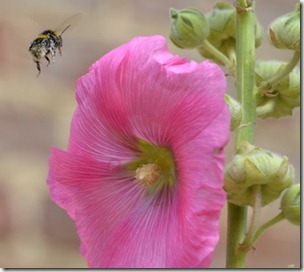
Early one morning before opening up I sat on the lawn and made a measured sketch. I noticed that a very still little white tailed bumble bee was curled round the stamen of one of the flowers.
I rather think he had been there overnight. I
was a good half hour and he was still there when I left. I have seen them here sheltering under teasels for the night.
Bee in Hollyhock… not easy to see him curled round in the middle.
My slow measured sketch…
Later a quicker sketch with black and white pens on toned paper.
Back in the studio in between talking to the visitors I drew a pod and its little adjoining leaf. The pods are delightfully furry.
It’s a bit like the old “Leaf of the Day” times! I still have to draw the seeds but have brought a few pods back with me, along with some honesty.
Nice! I am looking forward to drawing them.
Hollyhock Seed Pod and Leaf
Walk /Sketch:Day Seven. Water Tower and More Bee Sketches
I am doing some more work on my Bombus hypnorum.
The pretty Tree Bumblebee who is quite new to the UK. I will paint the one I saw at Easton in May who was busy on the cherry blossom.
I looked through my photos again and see I have photographed both male and female over the last few months.
They are very similar but the male has a ginger section on the abdomen and a top knot of ginger hairs. They are really quite delightfully hairy with long silky hair and their wings seem quite long when compared with other bumble bees.
They are certainly spreading throughout the country now, its ten years since the first records, and it seems they are a benign invader. The sketches are useful just to get re-acquainted with the bee.
I think I have finally decided on the position of the bee on the page and its size. It is vital to get all this sorted out now as changes are not really possible…well, not once you have put the first layer of paint down.
I am using my rather blurred photo for the pose inspirations, and I do have a little model which I can use when I paint the final piece. It’s taken me two hours just playing around with various possibilities.
I think I will be painting this later in August. At Nature in Art I hope to be sketching and making studies from their lovely garden.
Grafham Water Tower The local Post Office is in the next village and I had a couple of things to post so cycled over there.
On the way you pass the water tower which comes as a bit of a surprise as you round a corner.
It stands in its own neglected and weedy plot of land and there are dire warnings of DANGER and risk of “Non Ionising Radiation”.
I am fascinated by water towers. In Lincs you can orient yourself by their positions on the skyline. They are strange, blank looking edifices. They seem silent and tight lipped as if they hold a private secret. I have to admit I have never seen inside one.
I made a little thumbnail sketch then started a larger one. It was cold today and I wasn’t sure if I really wanted to stay out for long. I took a snap of the pencil stage.
I don’t usually use do pencil prelim when I am out sketching as I feel it makes me too fussy but drawing buildings makes me nervous. I feel I need to work it all out before committing to pen. Silly really! I just need more practice!
Maybe the Church tomorrow.. well maybe just a bit of it!
I like the tinted paper because you have a mid tone already there for you!
I might add a bit of sky to this …but no more time today.

